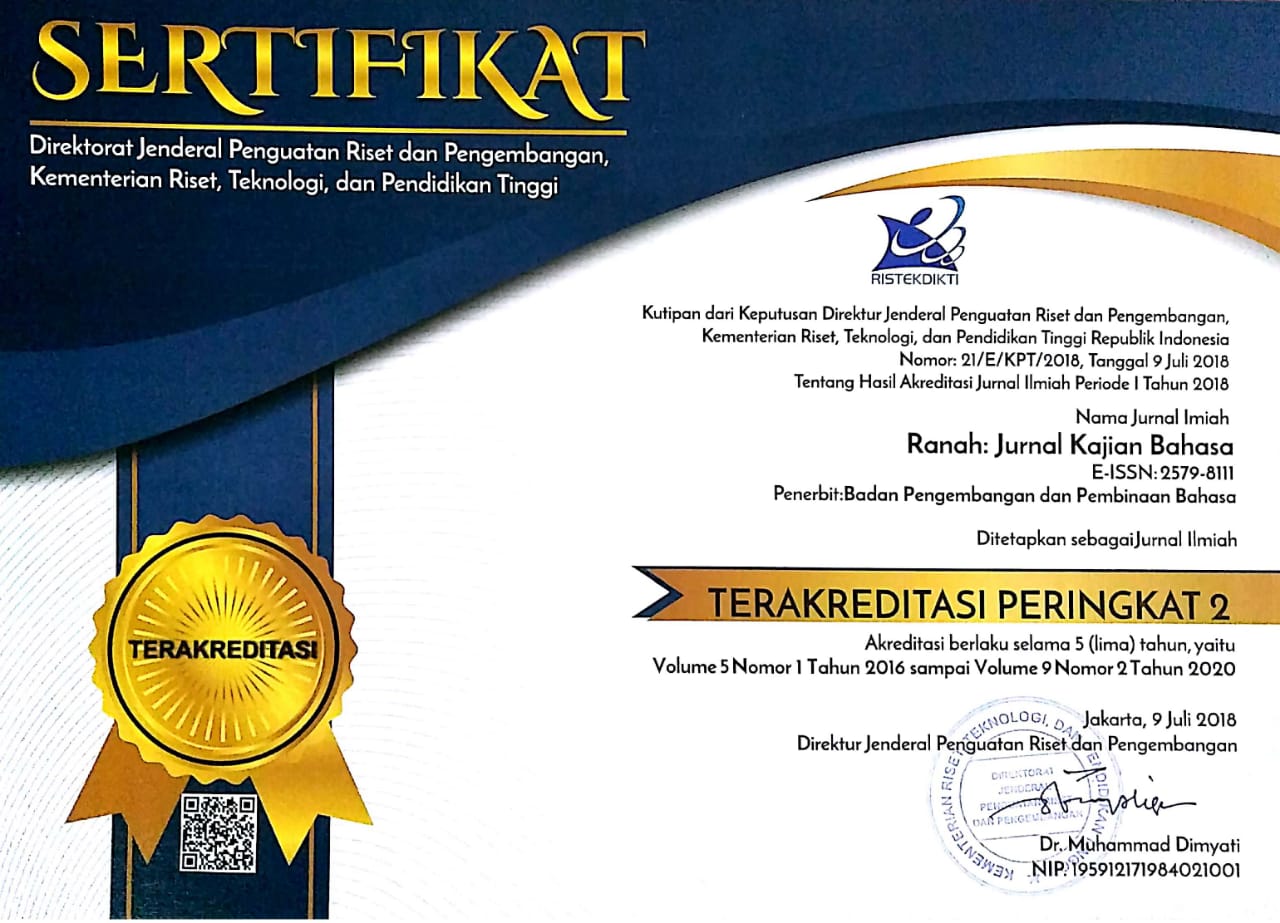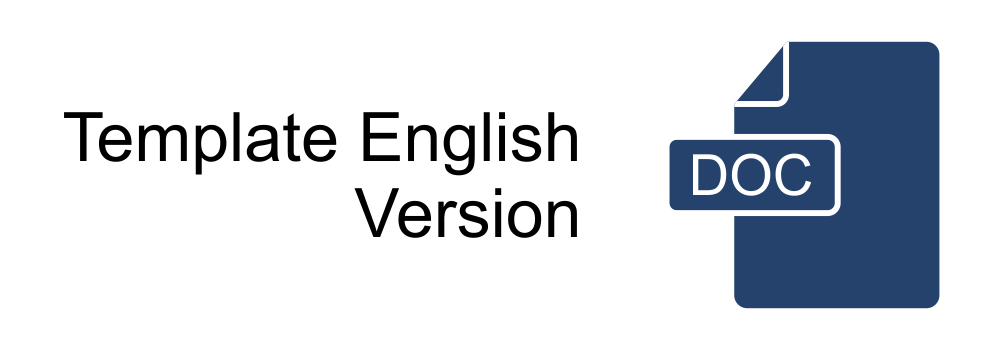Harmoni Bahasa dari Persfektif Penerjemahan dalam Kasus Pemadanan Istilah Teknis
Abstract
The language harmony in this study is oriented to the idea of the awakening of sincronized or similar object, concept, definition and term in relation to the terms adoption strategy by a general translation from one language to another (donor by recipient language). Terms are important pillars in the science systems that they must have the same meaning for everyone using it so the information exchange will obtain a good result. Thus, through a general consensus on meanings, names and specific terms along with the usages consistently will result in the uniformity of a special vocabulary containing the standard concepts, terms and definitions. The data collecting method is by browsing electronic library (e-lib) with data source taken as samples such as (1) Phonological adaptation of borrowed terms in Duramazwi reMimhanzi, (2) Translation journal of translation procedures, strategies and methods, (3) Are there connections between English and Romanian terminology in Medicine?, (4) Third-year students’ difficulties in translating computing terms from English into Arabic, (5) Studying Loanwords and Loanword Integration: Two Criteria of confirmity. The analysis is conducting by observing phonological aspects phenomenon (concerning pronunciation system) and orthographic aspect (concerning writing system). Based on these data, it is shown that the technical term equivalence strategy is conducted through the adjustment of sound and the foreign writing system (donor language) with changes based on the phonological system according to the pronunciation and the orthography system of a language (recipient language). The strategy is an attempt to maintain the full meaning of the concept contained in the terms of a language which meaning is not revealed in other languages in order to establish harmony or similarity of vision in the context of the use of the term to build language harmony among language speakers or users.
Abstrak
Istilah merupakan sendi penting di dalam sistem ilmu pengetahuan, harus mempunyai makna yang sama bagi semua orang yang menggunakannya, agar pertukaran informasi memperoleh hasil yang baik, maka melalui kesepakatan umum tentang makna, nama dan istilah khusus serta penggunaannya secara konsisten akan menghasilkan keseragaman suatu kosa kata khusus yang memuat konsep, istilah, dan definisinya yang baku.Artikel ini merupakan hasil kajian bidang penerjemahan tentang suatu pendekatan yang terkait dengan peristilahan, khususnya istilah teknis (technical terms). Sejumlah pendekatan yang dapat disajikan adalah sebagai alternatif dengan mengacu pada prinsip-prinsip kesamaan konsep antara bahasa sumber dan bahasa target (donor and recipient language). Data dalam kajian ini diperoleh melalui akses internet (online) untuk memperoleh jurnal, artikel dan referensi lain yang mengkaji masalah peristilahan dan aspek-aspek linguistik secara tekstual yang berorientasi pada bidang penerjemahan. Hasil dari kajian ini menunjukkan bahwa bentuk interakasi di antara berbagai bahasa dalam bidang penerjemahan, khususnya menyangkut istilah teknis dapat dilakukan dengan pendekatan penyesuaian aspek kebahasaan atau kaidah linguistik bahasa donor menurut aspek atau kaidah kebahasaan bahasa penerima (recipient language). Hal ini dilakukan adalah sebagai upaya untuk mempertahankan makna konsep yang dimiliki bahasa donor di satu sisi, dan upaya menyesuaikan aspek atau kaidah linguistik menurut bahasa penerima di sisi lain. Dengan demikian, harmoni bahasa dapat terbangun bagi penutur atau pengguna bahasa di antara komunitas bangsa itu sendiri.
Keywords
Full Text:
PDFReferences
Adbellah, Antar Solhy.(2003).The Problem of Translating English Linguistic Terminology into Arabic.Camling Proceedings Editorial Team.Camling Proceedings 1:100-101..SOAS, University of London.
Arndt et al. (2015).Smart grid terminology development—crossing the boundaries ofterminology standardization.Energy, Sustainability and Society Springer Open Journal.Institut für Verkehrssicherheit und Automatisie rungs technik, Technische Universität Braunschweig, Hermann-Blenk-Straße 42, 38108 Braunschweig, Germany.
Benitez, P., Faber. (2009). The Cognitive shift in Terminology and SpecializedTranslation.MonTI 1.Artikel.University of Granada.
Chiocchetti, Elena & Voltmer, Leonhard. (2008). Harmonising Legal Terminology. Bolzano-Bozen.Roma.
Desmet, I., Boutayeb, S. (1994). Terms and words: Propositions for terminology. In:
Terminology, 1 (2), pp. 303-325. Amsterdam, Philadelphia: John Benjamins Publishing Company.
Draskau, Jennifer dan Heribert Picht.(1985). Terminology: an introduction. Guilford: University of Surrey.
Froemel, Esme Winte. (2006). Studying Loanwords and Loanword Integration: Two Criteria of Conformity. School of Modern Languages Research Seminar. Seminar and Conference . Newcastle upon Tyne (pp. 159) United Kingdom.
goygoy in social sciences. (2011). Language can Cause Conflict. Retrieved September 19, 2012 from socyberty.com/social-sciences/language-can-cause-conflict, diakses:19 Oktober 2015.
Gusi, Beatriu Krayenbühl i. (1998).Universal Declaration of Linguistic Rights. Orlando (Florida), Harcourt Brace & Company (Originated work published 1995) .
ISO 10241-2. (2012). Terminological entries in standards-Part 2: Adoption of standardized terminological entries. First edition, reference number : ISO 10241-2:2012(E). Switzerland.
ISO 704. 2009. Terminology work—principles and methods. Geneva: ISO.
Kalliokuusi, Virpi dalam Perälä, Satu. (2014). Terminology Management As a Part of Documentation Development. School of Language, Translation and Literary Studies English Language and Literature. Thesis. University of Tampere. Finland.
Králíková, Kamila. (2010). Basic Aspects of Terminology Management.Department of Englishand American Studies. Bachelor‘s Diploma Thesis. Masaryk UniversityFaculty of Arts.
Kudashev, Igor & Kudasheva, Irina. (2010). Semiotic Triangle Revisited for the Purposes of Ontology-Based Terminology Management.Actes de la conference, (pp.12). Hilsinski. Finland.
Laurén, Christer, dalam Perälä, Satu. (2014). Terminology Management As a Part of Documentation Development.School of Language, Translation and Literary Studies English Language and Literature.Thesis. University of Tampere. Finland.
Marklund, Asa. (2011). Translation of Technical Terms.a study of translation strategies when translating terminology in the field of hydropower generation. School of Language and Literature. Linnaeus University.
Myking, Johan. (2001). Sign Models in Terminology: Tendencies and Functions. conference in Vienna. University of BergenNorway. Published in LSP & Professional Communication, volume, 1(2), ISSN 1601-1929.
Mykolaitytė, Indrė dan Liubinienė, Vilmantė.(2007). Linguistic and Cultural Adaptation of English Websites into Lithuanian.Jurnal Studies About Languages. Kalbu Studijos. Faculty of Humanities University of Technology. Lituania. /ISSN /1648-2824- No.10(50).
Newmark, P. (1988b). Approaches to Translation. Hertfordshire: Prentice Hall.
Niederbäumer, Angela. (2000). German terminology of Banking: Linguistic Methods of Description and Implementation of a Program for Term Extraction Referent. Lizentiatsarbeit der Philosophischen Fakultät der Universität Zürich.
Nuopponen, dan Pilke.dalam Perälä, Satu. (2014). Terminology Management As a Part of Documentation Development. School of Language, Translation and Literary Studies English Language and Literature. Thesis. University of Tampere. Finland.
Nur, Muhamad. (2011). Istilah Teknis dan Permasalahannya dalam Penerjemahan. Jurnal Masyarakat Bahasa dan Sastra Nusantara, Vol. 5(1), Jan-Jun. (pp.72). Kantor Bahasa Provinsi Nusa Tenggara Barat.
Ogden, C.K. & Richards, I.A. (1989).The Meaning of Meaning.A study of the influence oflanguage upon thought and of the science of symbolism. London: Routledge & Kegan Paul.
Ordudari, Mahmoud. (2010). Translation procedures, strategies and methods.Translation Journal.
URL: http://translationjournal.net/journal/41culture.htm. akses, 03/01/2017.
Packeiser, Kirsten. (2009). The General Theory of Terminology: A Literature
Review and a Critical discussion. Master Thesis. International Business Communication Copenhagen Business School. hlm.30
Papel, Silvia dan Nolet, Diane.(2001). Handbook of Terminology. Terminology and Standardization Translation Bureau. Canada.
Perälä, Satu. (2014). Terminology Management As a Part of Documentation Development. School of Language, Translation and Literary Studies English Language and Literature. Thesis. University of Tampere. Finland.
Pinta, Jessica Atong & Yakubu, Joy aisy. (2014). Language Use and Political Correctness for Peaceful Coexistence: Implications for Sustainable Development. Department of General Studies, Plateau State Polytechnic, Barkinladi, Nigeria. YWCA, Nigeria -(ISSN 2239-978X - ISSN 2240-0524). Journal of Educational and Social Research. MCSER Publishing, Vol. 4 No.5(.pp. 29). Rome-Italy.
Reynolds, Katsue Akiba. (2000). Argument Culture and Harmony Culture --a study ofphatic communication in Japanese(Draft--comments appreciated). Prepared for the Pacific and Asian Communication Association Convention
Honolulu, Hawaii, August 10-11,2000. University ofHawaii at Manoa.
Rusko, Tatjana. (2010). English Computing Terminology as a System. JurnalSantalka Filologija Edukologija.Vilnius Gediminas Technical University.Vilnius, Lithuania. ISSN 1822-430X print/1822-4318 online.
Sager, Juan C. dalamPerälä, Satu. (2014). Terminology Management As a Part of Documentation Development. School of Language, Translation and Literary Studies English Language and Literature.Thesis. University of Tampere. Finland.
Sanastotyön käsikirja, dalam Kudashev, Igor & Kudasheva, Irina.(2010). Semiotic Triangle Revisited for the Purposes of Ontology-Based Terminology Management. Actes de la conference. Hilsinski. Finland.
Schmitz, Klaus-Dirk (2006). Terminology and Terminological Databases. In Keith Brown(ed.) Encyclopedia of Language and Linguistics.2nd ed. Vol. 1. Oxford: Elsevier, 578–587.
Seuren, Pieter A.M. (2006). Aristotle and Linguistics.In Keith Brown (ed.) Encyclopedia of Language and Linguistics.2nd ed. Vol. 1. Oxford: Elsevier, 469–471.
Soualmia, Meriem. (2010). Third-Year Students’ Difficulties in Translating Computing Terms from English into Arabic. Faculty of Letters and Foreign Languages Department of English. Thesis. People’s Democratic Republic of Algeria Ministry of Higher Education and Scientific Research Mentouri University- Constantine.
Suouuti, dalam Gibbon.(1999). Terminology for Spoken Language Systems.
Starkey, H. (2002).Democratic Citizenship, Languages, Diversityand Human Rights. Guide for the development of Language Education Policies in EuropeFrom Linguistic Diversity to Plurilingual Education. Reference Study.The Open University, Milton Keynes. Language Policy Division.Directorate of School, Out-of-School and Higher EducationDGIV.Council of Europe, Strasbourg.
Stiegelbauer, Laura R.P. et al. (2012). Are there Connections between English and Romanian Terminology in Medicine?International Conference on Language, Medias and Culture IPEDR.IACSIT, vol.33. Press Singapore.
Sugono, Dendy.(2007). Pedoman Umum Pembentukan Istilah.Departemen Pendidikan Nasional. Ed.(3). Cet.(4). Pusat Bahasa. Jakarta.
Tama, Toma Patriot.(2013). Harmoni “Bersama untuk Bergerak” http://tomapatriottama. blogspot.co.id/2013_04_01_archive.html, diakses: 31 Desember 2015.
Teleoaca, Anca Irinel. (2004). Internet and Cultural Concepts from a Translation Perspective.Journal, vol. 8(1).URL://accurapid.com/journal/27romania.html.
Torner, Carles.(1998). Universal Declaration of Linguistic Rights.Communications media and new technologies. Article 40, sec. IV.p.29.
UNESCO.(2005). Guidelines for Terminology Policies, Formulating and implementing terminology policy in language communities.United Nations Educational, Scientific and Cultural Organization. Paris.
Wang, dkk. (2012). Harmony as language policy in China: an Internet perspective. Tilburg Paper Culture Studies, (35).Understanding Society.Tilburg University.
Wikipedia Bahasa Indonesia. Ensinklopedia bebas. https://id.wikipedia.org/wiki/Bahasa_Shona.diakses 20 Desember 2016.
Zivenge, William dan Gift Mheta.(2009). Phonological Adaptation of Borrowed Terms in Duramazwi reMimhanzi.Jurnal dari Department of Linguistics, University of the Western Cape, Bellville, Republic of South Africa (2971565@uwc.ac.za).Dan African Languages Research Institute, University of Zimbabwe, Harare, Zimbabwe (williamzivenge@yahoo.com).Lexikos 19 Supplement (AFRILEX-reeks/series 19: 2009): 157-165. Dapat diiakses di http://lexikos.journals.ac.za.
DOI: https://doi.org/10.26499/rnh.v6i2.100
Refbacks
- There are currently no refbacks.








